You are using an out of date browser. It may not display this or other websites correctly.
You should upgrade or use an alternative browser.
You should upgrade or use an alternative browser.
Near-Earth objects and close calls
- Thread starter Gawan
- Start date
AMS event #7444-2020
It looks like the fireball that flowed at 1:26 on December 7, 2020 was seen with a wide-angle camera from Hiratsuka to the northern sky. It exploded twice at the end.
藤井大地 @dfuji1
It looks like the fireball that flowed at 1:26 on December 7, 2020 was seen with a wide-angle camera from Hiratsuka to the northern sky. It exploded twice at the end.
A newly-discovered asteroid flew past Earth at a very close distance.
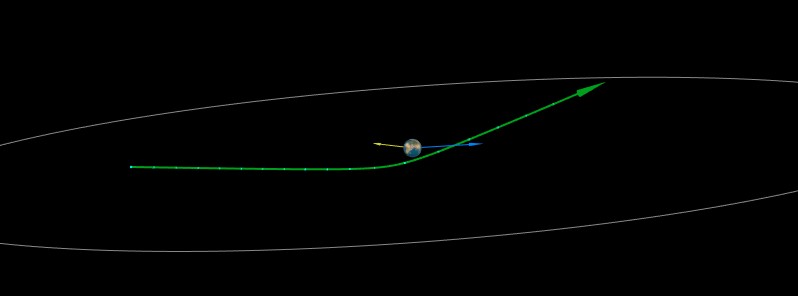
 watchers.news
Posted by Teo Blašković on December 8, 2020
watchers.news
Posted by Teo Blašković on December 8, 2020

Newly-discovered asteroid 2020 XK1 flew past Earth at just 0.05 LD
A newly-discovered asteroid designated 2020 XK1 flew past Earth at a very close distance of just 0.05 LD / 0.00014 AU (20 943 km / 13 013 miles) from the center of our planet at 16:15 UTC on December…
A newly-discovered asteroid flew past Earth at a very close distance.
Yep, another very close one.
It's like they're zeroing in on us.Yep, another very close one.
The 11-Jupiter-mass exoplanet called HD106906 b occupies an unlikely orbit around a double star 336 light-years away and it may be offering clues to something that might be much closer to home: a hypothesized distant member of our Solar System dubbed “Planet Nine.” This is the first time that astronomers have been able to measure the motion of a massive Jupiter-like planet that is orbiting very far away from its host stars and visible debris disc.
The exoplanet HD106906 b was discovered in 2013 with the Magellan Telescopes at the Las Campanas Observatory in Chile’s Atacama Desert. However, astronomers did not then know anything about the planet’s orbit. This required something only the Hubble Space Telescope could do: collect very accurate measurements of the vagabond’s motion over 14 years with extraordinary precision.
The exoplanet resides extremely far from its host pair of bright, young stars — more than 730 times the distance of Earth from the Sun. This wide separation made it enormously challenging to determine the 15 000-year-long orbit in such a short time span of Hubble observations. The planet is creeping very slowly along its orbit, given the weak gravitational pull of its very distant parent stars.
The Hubble team behind this new result [1] was surprised to find that the remote world has an extreme orbit that is very inclined, elongated and external to a dusty debris disc that surrounds the exoplanet’s twin host stars. The debris disc itself is very extraordinary, perhaps due to the gravitational tug of the rogue planet. This study was led by Meiji Nguyen of the University of California, Berkeley.
“To highlight why this is weird, we can just look at our own Solar System and see that all of the planets lie roughly in the same plane,” explained Nguyen. “It would be bizarre if, say, Jupiter just happened to be inclined 30 degrees relative to the plane that every other planet orbits in. This raises all sorts of questions about how HD 106906 b ended up so far out on such an inclined orbit.”
The prevailing theory to explain how the exoplanet arrived at such a distant and strangely inclined orbit is that it formed much closer to its stars, about three times the distance that Earth is from the Sun. However, drag within the system’s gas disc caused the planet’s orbit to decay, forcing it to migrate inward toward its stellar hosts. The gravitational forces from the whirling twin stars then kicked it out onto an eccentric orbit that almost threw it out of the system and into the void of interstellar space. Then a star passed very close by to this system, stabilising the exoplanet’s orbit and preventing it from leaving its home system. Candidate passing stars had been previously identified using precise distance and motion measurements from the European Space Agency’s Gaia survey satellite.
This scenario to explain HD106906 b’s bizarre orbit is similar in some ways to what may have caused the hypothetical Planet Nine to end up in the outer reaches of our own Solar System, beyond the Kuiper Belt. Planet Nine could have formed in the inner Solar System and was then kicked out by interactions with Jupiter. However, Jupiter would very likely have flung Planet Nine far beyond Pluto. Passing stars may have stabilised the orbit of the kicked-out planet by pushing the orbit path away from Jupiter and the other planets in the inner Solar System.
“It’s as if we have a time machine for our own Solar System going back 4.6 billion years to see what may have happened when our young Solar System was dynamically active and everything was being jostled around and rearranged,” explained team member Paul Kalas of the University of California, Berkeley.
To date, astronomers have only circumstantial evidence for the existence of Planet Nine. They’ve found a cluster of small celestial bodies beyond Neptune that move in unusual orbits compared to the rest of the Solar System. This configuration, some astronomers think, suggests that these objects were shepherded together by the gravitational pull of a huge, unseen planet. An alternative hypothesis is that there is not one giant perturber, but instead the imbalance is due to the combined gravitational influence of much smaller objects.
“Despite the lack of detection of Planet Nine to date, the orbit of the planet can be inferred based on its effect on the various objects in the outer Solar System,” explained team member Robert De Rosa of the European Southern Observatory in Santiago, Chile who led the study’s analysis. “This suggests that if a planet was indeed responsible for what we observe in the orbits of trans-Neptunian objects it should have an eccentric orbit inclined relative to the plane of the Solar System. This prediction of the orbit of Planet Nine is similar to what we are seeing with HD 106906b."
Scientists using the upcoming NASA/ESA/CSA James Webb Space Telescope plan to get additional data on HD106906 b to better understand the planet’s system. Astronomers want to know where and how the planet formed and whether the planet has its own debris system around it, among other questions.
“There are still a lot of open questions about this system,” added De Rosa. “For example, we do not conclusively know where or how the planet formed. Although we have made the first measurement of orbital motion, there are still large uncertainties on the various orbital parameters. It is likely that both observers and theorists alike will be studying HD 106906 for years to come, unraveling the many mysteries of this remarkable planetary system.”
Notes
[1] The data used in this study were taken as part the following Hubble Space Telescope observing programs GO-10330 (PI: Ford), GO-14670 (PI: Kalas), GO-14241 (PI: Apai) and GO-14241 (PI: Apai).
These results have been published in the Astronomical Journal.
More information
The Hubble Space Telescope is a project of international cooperation between ESA and NASA.
The international team of astronomers in this study consists of M. Nguyen, R. De Rosa, and P. Kalas.
A newly-discovered asteroid will pass close to Earth on December 18, 2020.
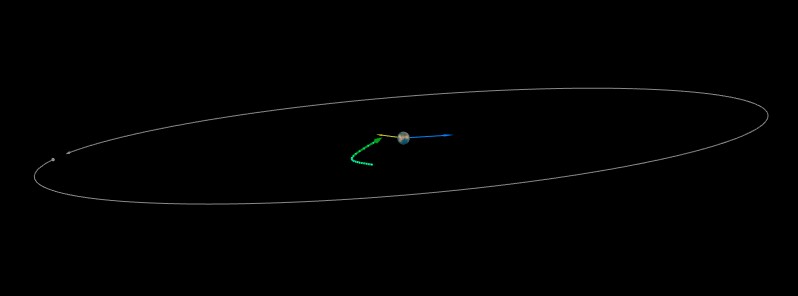
 watchers.news
Posted by Teo Blašković on December 12, 2020
watchers.news
Posted by Teo Blašković on December 12, 2020
 theskylive.com
theskylive.com

Asteroid 2020 XX3 to flyby Earth at 0.1 LD on December 18
A newly-discovered asteroid designated 2020 XX3 will fly by Earth at a distance of 0.15 LD / 0.00038 AU (56 847 km / 35 323 miles) from the center of our planet on December 18, 2020.
Asteroid (NEO) 2020 XX3 Information | TheSkyLive.com
All most important information and up do date information about Asteroid (NEO) 2020 XX3
Gemini meteor shower was very active last night, witnessing numerous sizes and brightness.
Others have noted within the research community of incoming objects from the unknown's, during the Gemini MS 2020.
Quote:

See: https://www.aanda.org/articles/aa/f...r8OgNwSR5hbw5YSY-EfzUhHPINOzLcYgHEguWKSu_Z4-E #spacerocks
These are the asteroids to worry about
Nov 30, 2020
Since @AstroHita The systems of the SMART project (Instituto de Astrofísica de Andalucía IAA-CSIC) have recorded the impressive show that the Geminids have offered last night, 1 day before reaching their maximum https://youtu.be/CCKQRGIeADk @LeoAstronomada
Others have noted within the research community of incoming objects from the unknown's, during the Gemini MS 2020.
Quote:
FRIPON confirmed that brightness and frequency of meteors have an inverse exponential relationship (so yes the dinosaurs got really unlucky). #FRIPON cameras catch #meteors brighter than mag -4, up to mag -9. Blue line is exponential.
See: https://www.aanda.org/articles/aa/f...r8OgNwSR5hbw5YSY-EfzUhHPINOzLcYgHEguWKSu_Z4-E #spacerocks
Results. Nearly 4000 meteoroids have been detected so far and characterized by FRIPON. The distribution of their orbits appears to be bimodal, with a cometary population and a main belt population. Sporadic meteors amount to about 55% of all meteors. A first estimate of the absolute meteoroid flux (mag < –5; meteoroid size ≥~1 cm) amounts to 1250/yr/106 km2. This value is compatible with previous estimates. Finally, the first meteorite was recovered in Italy (Cavezzo, January 2020) thanks to the PRISMA network, a component of the FRIPON science project.
These are the asteroids to worry about
Since @AstroHita The systems of the SMART project (Instituto de Astrofísica de Andalucía IAA-CSIC) have recorded the impressive show that the Geminids have offered last night, 1 day before reaching their maximum https://youtu.be/CCKQRGIeADk @LeoAstronomada
Last edited:
The scientific results released a short while ago showed that, coinciding with the peak of the twin meteors, the Emirates Network for Meteor Observation, affiliated to the International Astronomy Center in Abu Dhabi, in cooperation with the agency "NASA", managed to draw an orbit of 936 meteors last night! And this is done by calculating the trigonometry of meteors that were captured by more than one station!

 www.space.com
By Mike Wall 19 hours ago
www.space.com
By Mike Wall 19 hours ago
HD 106906 b is interesting for many reasons.
By Robin George Andrews Dec. 3, 2020
2-meter asteroid 2020 XK1 was a team effort. Catalina Sky Survey detected this near-impactor last night, then "handed off" the object to ATLAS-Haleakala, which continued tracking it so that it would not get lost. https://minorplanetcenter.net/mpec/K20/K20X5
3:03 AM · Dec 8, 2020·
Bolide #France#Yonne#Aube the 12/13/2020 at 17:41 CET Photographed by Joachim Kruse from Halver, North Rhine Westphalia #Allemagne
Denis Vida @meteordoc 4:02 PM · Dec 14, 2020
250x timelapse of the peak of the Geminids (1 video frame = ~10 seconds)
https://twitter.com/meteordoc/status/1338499617240064000

Bizarre alien world may be analog of our solar system's putative Planet Nine
HD 106906 b is interesting for many reasons.
HD 106906 b is interesting for many reasons.
Planet Nine may not be such an oddball after all, if it does indeed exist.
The exotic exoplanet HD 106906 b is an analog of sorts of Planet Nine, the Neptune-size world hypothesized to lurk in the outer reaches of our own solar system, a new study suggests.
HD 106906 b was discovered in 2013. It's about 11 times more massive than Jupiter and lies 336 light-years from Earth, near the double star HD 106906.
Related: When will we find Planet Nine?
The HD 106906 stellar duo is very young — just 15 million years old — and is still surrounded by a dusty debris disk. HD 106906 b apparently emerged from that disk but is now quite removed from it, zooming along high above the disk's plane. In addition, the giant exoplanet currently lies 737 astronomical units (AU) from the double star, about 25 times more distant from the pair than Neptune is from our sun. (One AU is the average Earth-sun distance, which is about 93 million miles, or 150 million kilometers.)
So HD 106906 b is a pretty curious character. Indeed, scientists have been debating whether the alien planet is still a bona fide member of the HD 106906 system or if it's now speeding away from the two stars, having been booted out by a gravitational interaction.
There's evidence that such a booting did take place: photos captured a few years ago by the Gemini South Telescope in Chile show that HD 106906's outer dust disk and inner comet disk are lopsided. HD 106906 b could have done this sculpting if the planet formed close to the system's center and was then kicked outward after a close encounter with the double stars, previous modeling work has indicated.
Such a disturbance would ordinarily send a planet out of its home system entirely, turning it into a "rogue" that wanders the galaxy alone, free of any host star — unless its departure was arrested by another gravitational interaction, this time with a star that wandered close to the HD 106906 system.
Last year, a group that included two of the three authors on the new study identified several stars that could have provided such a nudge about 3 million years ago. And the new paper suggests that one of those interloping stars may indeed have kept HD 106906 b from becoming a runaway.
In the new work, researchers led by Meiji Nguyen, a recent graduate of the University of California, Berkeley, analyzed observations of the HD 106906 system made between 2004 and 2018 by NASA's Hubble Space Telescope. The astronomers also compared the Hubble images with data gathered by Europe's Gaia spacecraft, which is precisely mapping the positions and movements of billions of stars in our Milky Way galaxy.
Related: The evidence for 'Planet Nine' in our solar system (gallery)
These combined data sets allowed the three scientists to nail down the positions of the HD 106906 binary and the giant planet. They found that HD 106906 b is likely in an elliptical and very long — but stable — orbit around its two parent stars, completing one lap every 15,000 years.
"Though it’s only been 14 years of observations, we were still able to, surprisingly, get a constraint on the orbit for the first time, confirming our suspicion that it was very misaligned and also that the planet is on an approximately 15,000-year orbit," Nguyen said in a statement.
"The fact that our results are consistent with predictions is, I think, a strong piece of evidence that this planet is, indeed, bound. In the future, a radial-velocity measurement is needed to confirm our findings," Nguyen added. (Radial-velocity measurements quantify the gravitational tug exerted by planets upon their host stars.)
What does this have to do with Planet Nine? The inferred history of HD 106906 b is similar to that proposed to explain how Planet Nine — or Planet Next, Planet X or Giant Planet Five, for those who will always regard Pluto as our solar system's ninth planet — could have gotten into, and remained in, its putative orbit, a highly elliptical path that keeps it hundreds of AU from the sun.
"What I really think makes HD 106906 b unique is that it is the only exoplanet that we know that is directly imaged, surrounded by a debris disk, misaligned relative to its system and is widely separated," Nguyen said. "This is what makes it the sole candidate we have found thus far whose orbit is analogous to the hypothetical Planet Nine."
The new study was published online this week in The Astronomical Journal. You can read a preprint of it for free at arXiv.org.
Mike Wall is the author of "Out There" (Grand Central Publishing, 2018; illustrated by Karl Tate), a book about the search for alien life. Follow him on Twitter @michaeldwall. Follow us on Twitter @Spacedotcom or Facebook.
By Robin George Andrews Dec. 3, 2020
As Douglas Adams once said: Space is big. Really big. Consequently, scientists see only tiny slivers of space at any given moment, so on those infrequent occasions when something new is observed, it’s a revelatory delight.
Astronomers recently witnessed an enigmatic icy object in Jupiter’s shadow begin its transformation into a type of comet, one that sticks close to the sun. It’s the first time they’ve watched this happen.
The object, named LD2, is called a Centaur, an icy proto-world named after mythological part-person, part-horse creatures because these orbs can behave like an asteroid and a comet. Centaurs hang out between Jupiter and Neptune. Constantly pulled at by the gravity of the gas and ice giants, they are usually either expunged from the solar system, or they are thrown toward the sun. In that case, they become hyperactive comets, orbiting the sun along a highly elliptical racetrack that doesn’t extend too far beyond Jupiter.
According to a study published last month in The Astrophysical Journal Letters, the chaos of this gravitational battle royale has determined that LD2 is going to set up shop in the inner solar system. Forty-three years from now, this Centaur’s transition will be complete. It will be fizzing and bubbling as it is braised by the sun, becoming the newest member of the so-called Jupiter Family of Comets.
The migration of comets and soggy asteroids from the fringes of our stellar neighborhood toward the rocky inner worlds was like a water delivery service in the early days of the solar system, slaking the thirst of planets drying out because of giant impacts and planetwide magma oceans. LD2’s encroachment will allow astronomers to see what happens when a pristine icy object makes a daring dive toward the sun, providing an enlightening echo of eras past.
Meg Schwamb, an astronomer at Queen’s University Belfast who was not involved with the study, said that scientists tended to get only snapshots of space phenomena. This time, we get to see an entire cosmic process play out from start to end. “We have a front-row seat,” she said. “You can get your popcorn out.”
Many millions of years ago, LD2 was an icy object beyond Neptune’s orbit. The planet’s gravity ensnared it and brought it into the space between Jupiter and Neptune.
In 2019, the Asteroid Terrestrial-impact Last Alert System or ATLAS, a pair of NASA-funded telescopes developed by the University of Hawaii that search for potential city-killing and country-crushing space rocks, spotted an object that appeared to be tracing Jupiter’s orbital path. Astronomers named it P/2019 LD2, or LD2 for short.
On closer inspection, its orbit was found to be suspiciously wobbly. Orbital calculations suggest that it got a bit too close to Jupiter’s massive gravitational force in 2017. Like a cyclist going around a velodrome encountering a sudden steep drop, LD2 was thrown off-balance, putting it on course to fall toward, and ultimately remain mostly within, the inner solar system.
It was also found to be rather excitable: Astronomers could see escaping icy matter forming a hazy cloud called a coma, and a tail rocketed out into the inky beyond. But its coma lacks water vapor, said Teddy Kareta, a planetary astronomy graduate student at the University of Arizona and co-author of the study. Combined with models of its orbital evolution, this suggests LD2 has not yet visited the inner solar system. Scientists caught it just as it started its first journey into the warmer region around our sun.
By 2063, LD2 will be shooting around our local star at breakneck speeds, completing one orbit roughly every six years. Being close enough to the sun, its water ice will be persistently obliterated, fueling a water vapor coma. “And water-driven activity is usually what we think of as a comet,” said Jordan Steckloff, a research scientist at the Planetary Science Institute in Tucson, Ariz., and the study’s lead author.
Considering the epic length of astronomical time scales, LD2’s fleeting saga is unusual. Its evolutionary journey is happening in lock step with our day-to-day existence. A young astronomer can follow its entire transition, from youth to cometary adulthood, and still be alive at its conclusion.
LD2’s ephemerality isn’t lost on scientists. “To see something that’s so short-lived, that’s changing — it’s a reminder that the solar system is dynamic,” Dr. Schwamb said. “It is a changing being, in some sense, just like us.”
2-meter asteroid 2020 XK1 was a team effort. Catalina Sky Survey detected this near-impactor last night, then "handed off" the object to ATLAS-Haleakala, which continued tracking it so that it would not get lost. https://minorplanetcenter.net/mpec/K20/K20X5
3:03 AM · Dec 8, 2020·
Bolide #France#Yonne#Aube the 12/13/2020 at 17:41 CET Photographed by Joachim Kruse from Halver, North Rhine Westphalia #Allemagne
Denis Vida @meteordoc 4:02 PM · Dec 14, 2020
250x timelapse of the peak of the Geminids (1 video frame = ~10 seconds)
https://twitter.com/meteordoc/status/1338499617240064000
Last edited:
Five asteroids are headed towards Earth, NASA warned.

 www.rt.com
16 Dec, 2020
www.rt.com
16 Dec, 2020

Parting gift from 2020? NASA warns FIVE asteroids headed this way
As the widely perceived terrible year of 2020 draws to a close, NASA has shared an alert about five asteroids due to shoot past the Earth on Wednesday and later this week, two of which will come closer to our planet than the Moon.
What Causes the Mass Extinction Cycles? When palaeontologists study extinctions events a very curious pattern appears. We have discussed our motion along twisting birkeland currents both on this channel and on the Thunderbolts. We speculated that the idea of the Nemesis Star and it’s 26 Millions Year extinction may be linked to our motion around the Pleiades. In a new study just published scientists have examined the frequency of extinction events in land animals and found that it coincides with reported mass extinctions of oceans life and points to a cycle of 27 Millions year. Let's examine why this might be a very important finding.
Three asteroids are headed towards Earth, NASA warned.
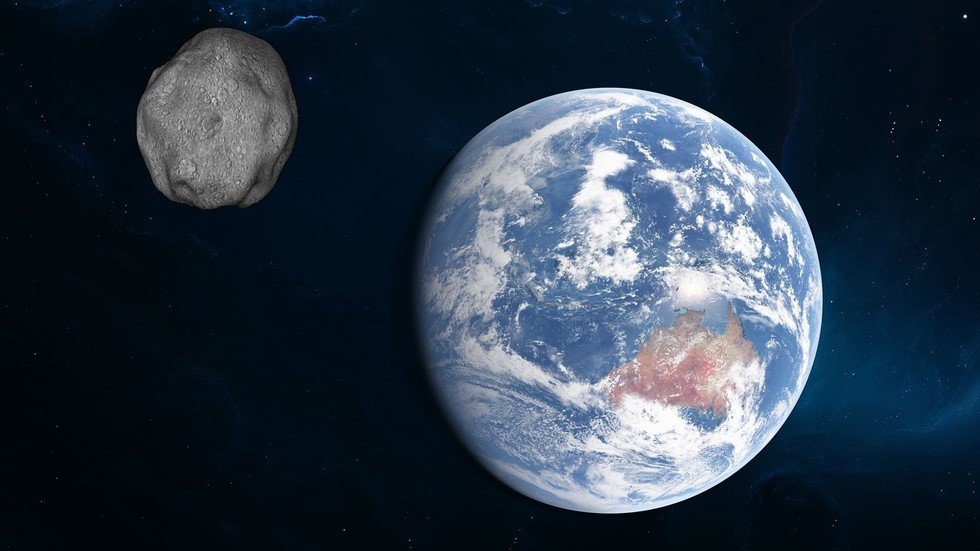
 www.rt.com
21 Dec, 2020
www.rt.com
21 Dec, 2020

NASA warns of THREE asteroids headed towards Earth, as Japan prepares for next mission to nearby space rock
As 2020 draws to a close and the number of existential threats to life on Earth appears to diminish at least slightly, NASA is warning about the close flybys of three asteroids over 40 meters in diameter.
Chad
The Living Force
Huge fireball reported over southern China early Wednesday morning. Locals reported hearing a huge bang. It apparently lasted for around 3 minutes and was detected by the regional earthquake centre, and they believe it may have reached the ground.
I haven't had much time to look into it but there's apparently official confirmation from Chinese agencies, there's videos taken from Chinese social media and shared by the American Meteor Society, and an article with a number of images and a video (which i am unable to embed) from the Daily Mail:
I haven't had much time to look into it but there's apparently official confirmation from Chinese agencies, there's videos taken from Chinese social media and shared by the American Meteor Society, and an article with a number of images and a video (which i am unable to embed) from the Daily Mail:

Huge ball of fire 'falls from the sky and crashes into a Chinese town'
Footage taken by stunned locals shows an unidentified object exploding into a blazing sphere as it plunges at a fast speed towards the county of Nangqian in north-western China today.www.dailymail.co.uk
Huge ball of fire 'falls from the sky and crashes into a Chinese county', leaving locals stunned
By Billie Thomson For Mailonline
- Giant fireball was spotted flashing across the sky today over Nangqian, China
- Footage shows the burning sphere exploding and plummeting into the county
- Local media suggested the fast-moving object could be a very bright meteor
- China's earthquake authority said a suspected bolide hit the earth at 7.25am
Published: 13:19 GMT, 23 December 2020 | Updated: 14:20 GMT, 23 December 2020
A giant fireball has been spotted flashing across the sky and crashing into a county in southern China.
Footage taken by stunned locals shows an unidentified object exploding into a blazing sphere as it plunges at a fast speed towards the earth.
It is not immediately clear what the ball of fire is, but local media are suggesting the possibility of a very bright meteor. No casualties have been reported.

The giant fireball was spotted flashing across the sky over Nangqian in China this morning
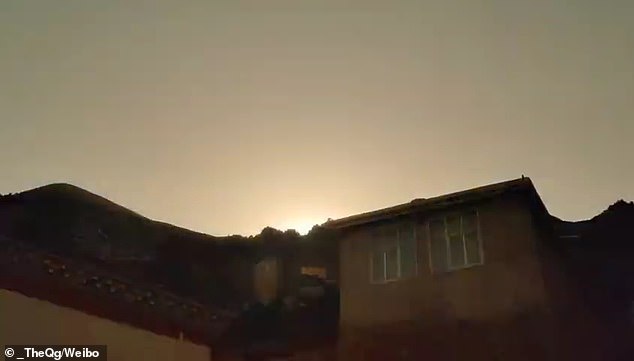
Various clips on the Chinese social media show the suspected meteor lighting up the sky
Various clips on the Chinese social media show the suspected meteor lighting up the sky as it plummets into the county of Nangqian in north-western China's Qinghai Province.
The incident is said to have occurred at around 7am on Wednesday. Local residents reported they had heard loud bangs.
One of the videos, shared by a science blogger on Twitter-like Weibo, captures the moment the fireball soars through the darkness as it is seen by a passenger on a flight from Xi'an to Lhasa.

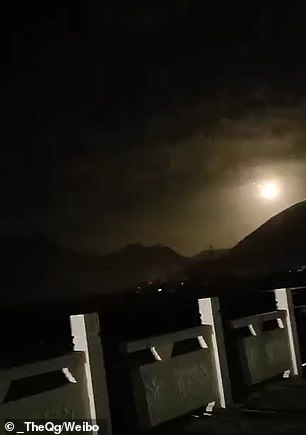
The incident is said to have occurred at around 7am on Wednesday in north-western China
In another piece of footage, the burning object is seen descending quickly towards hills and fields.
In a third clip, the fireball becomes brighter and bigger as it approaches the ground.
Dan Ba, a local, said he witnessed the fireball while taking his child to school.
'It started very small, but three minutes later it became very big and bright,' the parent told Pear Video.

One of the videos, shared by a science blogger on Twitter-like Weibo, captures the moment the fireball soars through the darkness as it is seen by a passenger on a domestic flight
Yu Jun, chief writer of Chinese science website Guokr, told Beijing News that the fireball looked like a bolide, which is a very bright meteor.
China Earthquake Networks Center said it had recorded the incident. The authority said through its social media account that a suspected bolide landed near the border between Nangqian County and Yusu County at 7.25am.
The Nanxiang County Government told Red Star News that it had heard of the matter but was unclear of the details.
Explained: The difference between an asteroid, meteorite and other space rocks
An asteroid is a large chunk of rock left over from collisions or the early solar system. Most are located between Mars and Jupiter in the Main Belt.
A comet is a rock covered in ice, methane and other compounds. Their orbits take them much further out of the solar system.
A meteor is what astronomers call a flash of light in the atmosphere when debris burns up.
This debris itself is known as a meteoroid. Most are so small they are vapourised in the atmosphere.
If any of this meteoroid makes it to Earth, it is called a meteorite.
Meteors, meteoroids and meteorites normally originate from asteroids and comets.
For example, if Earth passes through the tail of a comet, much of the debris burns up in the atmosphere, forming a meteor shower.
Last edited:
Chad
The Living Force
A few more videos including the vapor trail, and some data points (which are too technical for me!) on the fireball mentioned above. It's also up on SOTT:
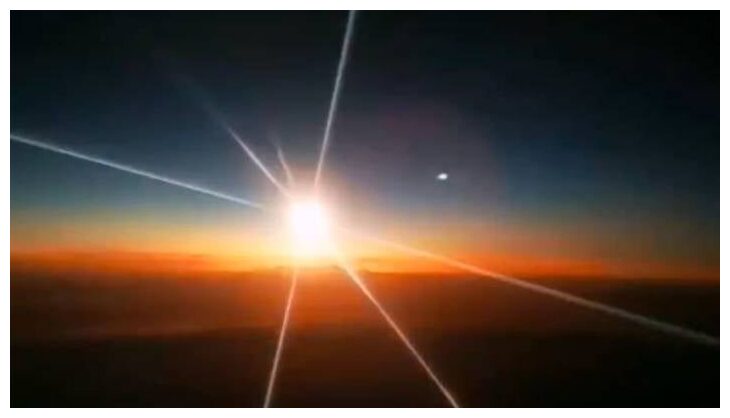
 www.sott.net
www.sott.net

HUGE meteor fireball lights up southern China's dark morning skies
A suspected low-flying meteor has lit up the sky in northwestern China's Yushu City on December 23. Video from the event in the city in China's Qinghai Province showed a bright fireball streaking across and lighting the dark sky. According to...
(Impact E=9.5 Kt)
Lat 31.9°
Lon 96.2°
2020-12-22 23:23:33
Altitude 35.5 km, Velocity 13.6 km/s Total radiated energy (J) 489.8e10
Impact Energy (kt) 9.5
Taken from NASA's Center for Near Earth Object Studies - Fireballs
